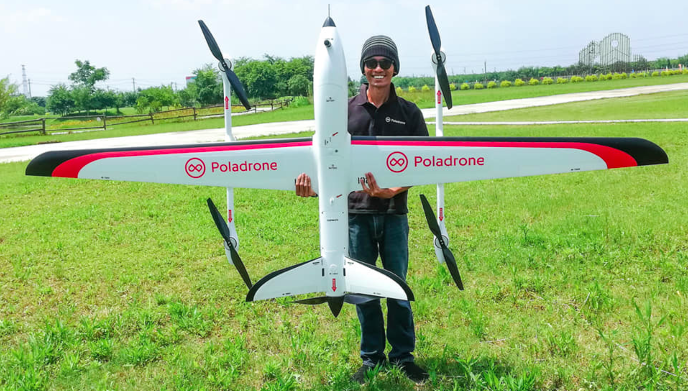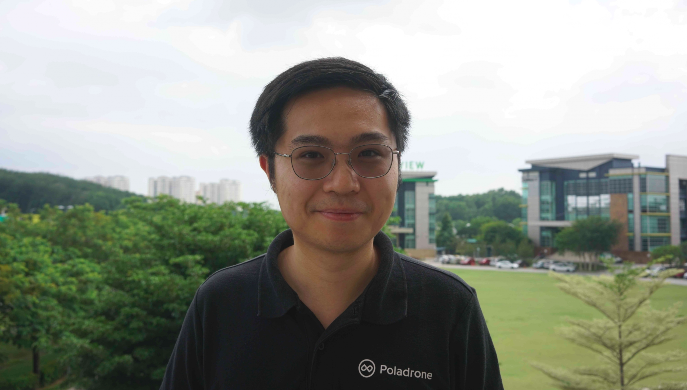
Jin Xi Cheong grew up in Kuala Lumpur and moved to Melbourne for higher studies when he was 14. He then went on to pursue a Bachelor Degree in Aerospace Engineering at Monash University.
In Late 2015, he returned to Kuala Lumpur to join Intel as a Finance Analyst.
“From a young age, I knew I would not be able to work in a corporate,” says Cheong, recounting his story to e27. “I was often the chief troublemaker at school and had a problem dealing with the authorities, especially when they went against my personal beliefs. I couldn’t change this behaviour. On the very first day at Intel, I told my manager that I would stay here only to learn things and that I would leave the firm if I found a better opportunity elsewhere.”
And this opportunity presented itself in the form of Poladrone.
Giving wings to his dream
While working at Intel, Cheong pursued aerial photography as a hobby. The initial idea was to make aerial photography easy for anyone.
He, however, quickly realised that while the hobbyist industry was famous in Malaysia, there were hardly any companies which utilised drones for solving industrial problems.
Also Read: Drones will revolutionise these 3 industries, so watch out
Cheong smelt an opportunity there and began working on it. He soon left Intel and started working full time in Poladrone.
His familiarity with agriculture came in handy when designing the products. The continuous improvements over the years shaped Poladrone into an unmanned aerial vehicle (UAV) company for agriculture solutions.
Data matters
Cheong created Poladrone in 2016 and was later joined by Co-founder Yong Guan, who also holds a Degree in Aerospace Engineering.
The company was started with an idea to make drones easily accessible to everyone. As time passed, the founders realised the real value of drones lies in the data that they can collect at scale. “Currently, Poladrone’s vision is to bring aerial insights (analytics) and automation to industries, with a focus on agriculture,” he explains.
The drones provided by the company can be used for data analytics and automation. Drones used to collect data are already available in the market, and Poladrone uses the best hardware for the job, he claims. On the other hand, drones used for automation would need to be customised for local use.
“We have recently developed a solution called ‘Airamap’, which helps simplify the entire data acquisition and analytics process for our customers. Our aim is to enable anyone with a drone to be able to unlock the potential of data, which can be captured using their existing equipment in a cost-efficient manner. We are launching the product at the end of this week,” he reveals.
The target segment

Anyone who manages assets/land over a large area or inaccessible areas is Poladrone’s customer. A bulk of its customers are in the agriculture, infrastructure and survey industries, in which it has mapped and analysed over 500,000 hectares of data so far. Five of the top 10 oil palm plantations in Malaysia, besides many large enterprises and government agencies in different industries, are its clients.
Also Read: 16-year-old Indian prodigy has developed a drone that can detect and destroy landmines
The company also rents out drones but with on strict conditions. “These are industrial-grade equipment that can cost over RM100,000 per set. Thus it requires the companies who rents the drones to have qualified pilots and an excellent safety record of flight operations,” he emphasises.
The market for drones is still nascent in Southeast Asia but is growing at a rapid rate. In his opinion, the drone tech is unique in a way that it is an enabler which can be applied across multiple industries. However, the applications of drones are not fully explored yet.
Gearing up for Indonesia launch
Poladrone is currently headquartered in Cyberjaya with branch offices in Bintulu, Sarawak and Bangkok, Thailand. The startup is now gearing up for expansion into Indonesia in 2020.
Like any other startup, Poladrone also had its fair share of setbacks, but they are insignificant when compared to a critical mistake that the founders made during the product launch.
“We were planning for the launch of a product, and I got carried away by putting too much importance in making the launch look good, instead of targeting the right audience. A lot of things went wrong, but in summary, we realised that we trusted the wrong partner and ended up burning quite a lot of resources without achieving our targets,” he shares.
The Echelon experience

Poladrone Founder and CEO Jin Xi Cheong
Poladrone was the winner of Echelon 2017. Cheong reveals that a lot has definitely changed since winning the title at Echelon 2017.
“When we won Echelon, we were an extremely early-stage startup, with only two of us in the company and barely any customers. Right now, we have over 35 full-timers in Poladrone with many stakeholders across multiple countries to manage. The responsibility and pressure of leading Poladrone have increased significantly but the impact that we make keeps the lights on at night,” he says.
In his opinion, Echelon is a perfect platform for early-stage startups to validate what you’re building with the public. Understanding the market and customers are fundamental to success in any company, and there is no better place than in front of hundreds of people on stage at the Top 100 pitch. Announcing your ideas and goals in public is the best form of commitment and inspiration to push for your best,” he concludes.
The post From a troublemaker in school to drone maker, this Malaysian entrepreneur is now living his dream appeared first on e27.